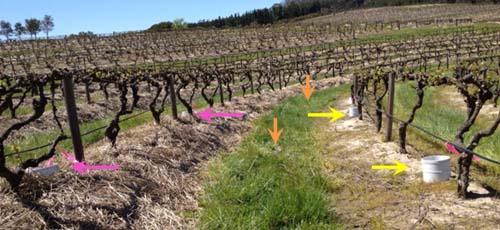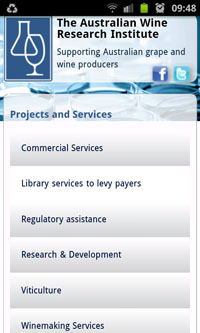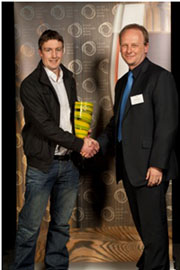The perfect yeast?
Found a fabulous fermentation?
Health and nutrition claims no longer on the label
Share what you know at Australia’s largest technical event
Events not to be missed in 2013: registration now open
Finalists in women’s R&D State award in grape and wine
Recent literature
The perfect yeast?
Finding it hard to match the perfect yeast to your grapes? Are you confident of the flavour profile you’ll get from the fermentation? What about the mouth-feel and texture of the wine? Here are the AWRI’s top 5 tips to achieve fermentation reliability and optimal flavour characteristics from yeast.
A winemaker‘s KPI is to efficiently produce the best possible wine from a given batch(es) of grapes, which is promoted by a thoughtful choice of yeast. The yeast strain chosen not only impacts on reliability of fermentation but also modulates the wine’s flavour profile, especially aroma, flavour in-mouth and texture. The large range of commercial yeasts provides winemakers with considerable flexibility in choosing the most suitable strain to match must composition and required wine chemical and flavour specifications. Here, the AWRI focuses on yeast properties most important for conventionally inoculated red and white dry wine fermentations.
Before choosing a strain it is important to have a clear description of the wine’s flavour profile and style. Grape maturity at harvest is a key factor which, together with yeast choice, strongly impacts on ethanol, pH and acidity, phenolics profile (colour and texture) and grape and yeast derived flavours. Yeast can be chosen which greatly augment varietal characters, such as fruity or tropical aromas, or tannin extraction, or, on the other hand, some strains can help mask undesirable flavours, such as ‘green’ flavour.
Winemakers have very little restriction on the choice of yeast when fermenting musts with well-balanced chemical and nutrient profiles, that is, those which require minimal intervention through to finished wine. In this case, choice can focus on strains which augment the winery’s varietal style. In all other cases, a number of criteria should be considered to ensure optimisation of fermentation and flavour. However, an important point to remember is not to dramatically change winery practices without first trialling their efficacy over several vintages.
Fermentation reliability
- Fermentation reliability – strain tolerance to ethanol stress: grape maturity has the greatest impact on fermentation reliability since yeast vary in tolerance to ethanol. This property is most evident in highly clarified musts and least in high solids ferments. It should be remembered that many commercial strains have been selected in Europe or elsewhere in which must composition varies greatly from those here, such as lower sugar and higher nitrogen and acidity, meaning that performance can be compromised in Australian juices. Rehydration and fermentation nutrients can increase fermentation robustness but diammonium phosphate (DAP) is important for ameliorating low yeast assimilable nitrogen (YAN) juices and an aeration step can greatly enhance fermentation and reduce residual sugar. Whereas many complex yeast nutrient products can modulate aroma profile, few contain significant YAN necessary to off-set nitrogen deficiency.
- Yeast sulfite and pH tolerance: research in progress at the AWRI (Schmidt 2012-13) has shown that some strains are hyper-sensitive to SO2 in combination with low pH, especially in highly clarified musts, which have low potassium content. This fact is gaining importance with the current wine style trend towards earlier harvest fruit. Furthermore, higher and more effective SO2 additions lower the risk of nutrient competition from indigenous yeasts (such as when delays in transport or processing occur) and incomplete fermentations from spoilage bacteria, especially with physically damaged (e.g. bird, split, heat) or fungal infected fruit. Effective SO2 use enhances Saccharomyces fermentation dominance, and hence an ability to impart strain-specific characteristics. However, care should be taken with non-Saccharomyces yeast which have lower SO2 tolerance.
- Flavour enhancing yeasts: in general, the yeast strain can either have a neutral impact on wine flavour profile, produce strong esters or can enhance varietal character. Grapes that lack varietal distinction can benefit from moderate to high fruity ester production, especially for quick-to-market wines, whereas some varieties, e.g. Sauvignon Blanc, and rosé style can benefit from varietal aroma enhancing strains. Some strains can augment the phenolics profile, such as in Pinot Noir. Some strains can build aroma complexity, such as hybrid, non-Saccharomyces cerevisiae (e.g. S. bayanus) or non-Saccharomyces strains (e.g. T. delbrueckii, Kl. thermotolerans) and some strains can help mask undesirable flavours, such as ‘green’ (e.g. some Sacchromyces hybrids, S. bayanus) (Eglinton et al. 2005, Bellon et al. 2007).
- Off-flavours, notably hydrogen sulfide and wine ‘reduction’: For musts prepared from vineyards which have a history of producing reductive wines, especially for those in which nutrient (e.g. DAP or complex/inactivated yeast products) addition or aeration during fermentation is not successful, can benefit from low/nil H2S-producing strains developed by the AWRI. These strains might lower the requirement for fining, such as with copper.
- MLF incompatibility and off-flavours: the phenomenon of MLF-unfriendly fermentation yeast is now well recognised and is considered a key factor in increasing the risk of wine spoilage, especially Brett, and spoilage bacteria (mousy off-flavour, biogenic amines) during the prolonged onset of MLF. When such delays, which are not related to well-known inhibitory factors (e.g. inappropriate pH, SO2, temperature and/or alcohol), have been experienced in the past, yeast-ML bacteria compatibility should be strongly considered.
Flavour characteristics
Found a fabulous fermentation?
When the stars and moons all align and you’ve created a cracker fermentation, wouldn’t it be great if you could repeat it again next year? Help is at hand. The AWRI can help you to repeat that fermentation by isolating the related yeast or bacteria and storing it for future use.
The AWRI can identify the yeast responsible for that extraordinary fermentation. Or, if there are interesting sensory properties in your wine, the AWRI can help find which yeast and/or bacteria were responsible. Perhaps your MLF went through quickly, or progressed well at a very low temperature, or in harsh wine conditions.
The AWRI Wine Microorganism Culture Collection team can help you. The AWRI can isolate and identify the yeast and bacteria and and can store them for you to use again.
Contact Jane McCarthy or Eveline Bartowsky on telephone 08 8313 6600 or by email.
Health and nutrition claims no longer on the label
The new Standard 1.2.7 – Nutrition, Health and Related Claims in the Australia New Zealand Food Standards Code was gazetted on 18 January 2013. There is a three year transition period for Standard 1.2.7 commencing 18 January 2013 during which time winemakers can use either the provisions in Standard 1.1A.2 – Transitional Standard – Health Claims or the new Standard 1.2.7. Winemakers cannot use a combination of the old and new provisions. There are no stock-in-trade provisions, so after 18 January 2016, all wine being sold will need to comply with the provisions of the new Standard 1.2.7.
Standard 1.2.7 clearly states that alcoholic beverages such as wine are not permitted to make either a nutrition content claim (except about energy or carbohydrate content) or a health claim on the label of the wine bottle or in product advertising. An example is that winemakers will no longer be able to include a measurement of the phenolic compounds, resveratrol, on the wine label, even as part of a nutrition panel. Should a winemaker make a nutrition content claim about energy or carbohydrate content, then a nutrition information panel (NIP) including all mandatory elements of the NIP will need to be provided on the label (refer to Standard 1.2.8 – Nutrition Information Requirements).
Provisions for the declaration of alcohol content on labels given in Standard 2.7.1 – Labelling of Alcoholic Beverages and Food Containing Alcohol, remain unchanged.
Standard 1.2.7 is available on the ComLaw website from the following link on the FSANZ website http://www.foodstandards.gov.au/foodstandards/foodstandardscode.cfm.
Standard 1.2.7 will be discussed in workshop W36 Winemaking, composition and labelling – what you need to know in the international arena at the Australian Wine industry Technical Conference on Tuesday, 26 July 2013 in Sydney. Further information can also be obtained from the FSANZ website at http://www.foodstandards.gov.au/consumerinformation/nutritionhealthandrelatedclaims/.
Extract from Standard 1.2.7
“Editorial Note:
Standard 1.1A.2 is a transitional standard that operates concurrently with this Standard 1.2.7 for a period of three years. During the three-year period Standard 1.1A.2 operates unchanged by this Standard and related variations made by the Food Standards (Proposal P293 – Nutrition, Health & Related Claims – Consequential) Variation. A supplier can rely on this Standard or Standard 1.1A.2, but not both. At the end of the three-year period, Standard 1.1A.2 will cease to operate. There is no stock-in-trade period at the end of the three-year period.”
Share what you know at Australia’s largest technical event
Presenting a poster at the 15th Australian Wine Industry Technical Conference is a great way to get your research work in front of Australia’s grape and wine producers. Poster abstracts are currently being accepted and must be sent by 5 April 2013.
Submit your poster abstract for a chance to win a prize or be selected to present your research in a ‘Fresh Research’ session at the Sydney Convention and Exhibition Centre, Darling Harbour. Posters will be displayed 14-17 July 2013. Online abstract submission and further information is available on the AWITC website by clicking here, or from Dr Eveline Bartowsky, Poster Coordinator. Poster abstract submissions close on Friday 5 April 2013 – don’t miss out on the opportunity to highlight your latest grape and wine research and outcomes to national and international industry members.
The 15th Australian Wine Industry Technical Conference will be held 13-18 July 2013 at the Sydney Convention Centre and further information can be obtained by clicking here.
Events not to be missed in 2013: registration now open
Registrations are now open to two international conferences for the Australian grape and wine industry (to be held in Sydney, July 2013). Register early to gain the benefit of discounted registration fees. Click here to register for the 15th Australian Wine Industry Technical Conference (13-18 July 2013 at the Sydney Convention Centre) or click here to download the registration form for the WineHealth 2013 conference (18-21 July 2013 at the Sydney Convention Centre).
The 15th Australian Wine Industry Technical Conference is held every three years and is the premier technical conference and trade exhibition held for industry members. The program covers all aspects of the grape and wine business and provides a valuable opportunity for sharing of information and networking with industry colleagues. More than 1,000 national and international delegates are expected and will be held 13-18 July at the Sydney Convention Centre. Complementing the program is an extensive technical poster display and 44 workshops. Workshops will be held from Saturday, 13 July through to Thursday, 18 July and places will be allocated on a first-come-first-served basis. Click here for further details of workshops on offer. Poster abstracts can be submitted (here) up to 5 April – so if you are undertaking work that the industry should know about, don’t miss this opportunity. Visit the AWITC website to see full details of the event program.
WineHealth 2013 continues the series of scientific international conferences discussing the complex interaction of wine and health (which have been held previously in Italy, USA, Chile, South Africa and France over the past 17 years). In 2013, the next conference will be held in Sydney from 18-21 July at the Sydney Convention Centre and is open to anyone interested in this topic. Information on the program and speakers are on the website (http://www.winehealth.com.au).
Finalists in women’s R&D State award in grape and wine
The AWRI’s Viticulturist, Mardi Longbottom and Cape Jaffa Wines winemaker, Anna Hooper have been selected from a strong field of entrants as South Australian finalists for the 2013 RIRDC Rural Women’s Award. The award supports women with leadership potential who have the desire and commitment to make a greater contribution to their industries and communities.
Now in its 16th year, the award provides rural women with the opportunity to realise their visions for primary industries and to meet a network of equally passionate and innovative peers.
South Australian Minister for Agriculture, Regional Development and the Status of Women, Gail Gago, said the two finalists were clearly very passionate about their chosen fields.
“These two women have a passion to share their knowledge and experience with other women in their industries,” Ms Gago said. “In turn they are also very keen to meet more women from across all primary industries, to learn and develop creative ways of doing business or undertaking research.
“They understand that it takes innovative ideas and courage to put them into practice to achieve success.”
The winner will receive a $10,000 bursary provided by the Rural Industries Research and Development Corporation (RIRDC) to implement a vision for their industry as well as a one week residential Australian Institute of Company Directors course, to enhance their leadership capabilities.
The 2013 SA RIRDC Rural Woman of the Year will be announced by Minister Gago on Wednesday 6 March 2013 at the Adelaide Pavilion.
The award is jointly sponsored by PIRSA, Westpac, ABC Radio and Fairfax Agricultural Media.
The 2013 RIRDC Rural Women’s Award finalists:
Dr Mardi Longbottom is a Viticulturist at The Australian Wine Research Insitute. She grew up on a farm in Padthaway; is a grape grower, viticulturist and viticultural consultant with 21 years’ experience in vineyard management, technical viticulture research, education and extension.
Mardi has enjoyed working with women across all areas of the grape and wine sector, and is passionate about sharing her knowledge and experience to stimulate and encourage the next generation of female viticulturists.
Mardi’s goal is to showcase positive female role models who are actively engaged in a diverse range of careers in the viticulture industry; and promote viticulture as an opportunity for varied and exciting career pathways to secondary and tertiary students.
Anna Hooper is a winemaker at Cape Jaffa Wines in the Mount Benson wine region near Robe. Dedicated to science and the environment, Anna has been instrumental in developing one of the first certified biodynamic wine ranges in South Australia.
Anna’s vision is to see the Australian Wine Industry recognised as a world leader in
environmental performance made up of environmentally savvy businesses valuing and investing in long term sustainability; and deriving associated benefits from their efforts.
Recent literature
John Fornachon Memorial Library at the AWRI delivers journal articles and loans books to Australian grapegrowers and winemakers. Books can be searched and requested via the Library catalogue – or you can email the AWRI with your request.
Recent AWRI staff publications
Bindon, K., Varela, C., Kennedy, J., Holt, H., Herderich, M. Relationships between harvest time and wine composition in Vitis vinifera L. cv. Cabernet Sauvignon 1. Grape and wine chemistry. Food Chem. 138 (2-3): 1696-1705; 2013.
Connew, S., Riggs, I. The show must go on. Wine Viti. J. 27 (6): 70, 72; 2012.
Costello, P.J., Siebert, T.E., Solomon, M.R., Bartowsky, E.J. Synthesis of fruity ethyl esters by acyl coenzyme A: alcohol acyltransferase and reverse esterase activities in Oenococcus oeni and Lactobacillus plantarum. J. Appl. Microbiol. doi:10.1111/jam.12098: 1-10; 2012.
Cowey, G. AWRI workshop wraps up packaging problems. Aust. N.Z. Grapegrower Winemaker (588): 71-72; 2013.
Dry, P. Nero d’Avola. Wine Viti. J. 27 (6): p.68; 2012.
Krstic, M.P. Spray application in vineyards – still the key to successful pest and disease management. Aust. N.Z. Grapegrower Winemaker (587): 28; 2012.
Longbottom, M. Ask the AWRI: What are the benefits of nutritional analysis and how do I get the most from the results? Aust. N.Z. Grapegrower Winemaker (587): 49; 2012.
McRae, J.M., Schulkin, A., Kassara, S., Holt, H.E., Smith, P.A. Sensory properties of wine tannin fractions: Implications for in-mouth sensory properties. J. Agric. Food Chem. 61 (3): 719-727; 2013.
Scrimgeour, N., Cynkar, W., Wilkes, E. Non-invasive spectroscopic screening: a new approach to assessing damaged wines. Aust. N.Z. Grapegrower Winemaker (582): 77-78; 2012.
Simos, C.A., Coulter, A.D., Henschke, P.A., Holdstock, M.G., Cowey, G.D., Essling, M. Managing diseased fruit. In Making the best out of difficult vintages: Managing sub-optimal fruit in the winery: proceedings of an ASVO oenology seminar held on 22 November, 2011:. 4 p.; 2013.
Ugliano, M., Henshke, P.A., Waters, EJ. Fermentation and post-fermentation factors affecting odor-active sulfur compounds during wine bottle storage. Qian, M., Shellhammer T.H. (Eds) Flavor chemistry of wine and other alcoholic beverages. ACS Symposium Series, Vol. 1104 189-200; 2012.
Disclaimer
The material contained in this publication is comment of a general nature only and is not and nor is it intended to be advice on any specific technical or professional matter. In that the effectiveness or accuracy of any technical or professional advice depends upon the particular circumstances of each case, neither the AWRI nor any individual author accepts any responsibility whatsoever for any acts or omissions resulting from reliance upon the content of any articles. Before acting on the basis of any material contained in this publication, we recommend that you consult appropriate technical/professional advisers.






